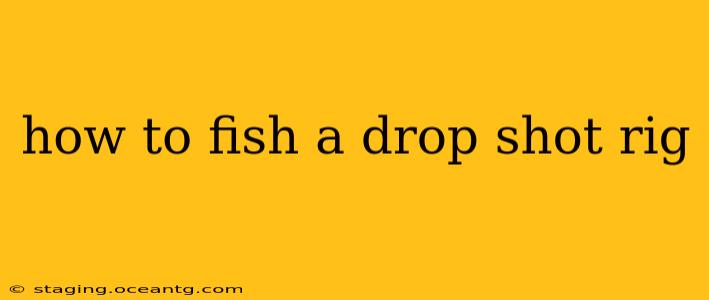The drop shot rig is a finesse fishing technique renowned for its effectiveness in targeting finicky fish. Its versatility allows anglers to adapt to various water conditions and fish species, making it a valuable asset in any angler's arsenal. This guide will delve into the intricacies of rigging, casting, and retrieving a drop shot, ensuring you master this productive technique.
What is a Drop Shot Rig?
The drop shot rig is a simple yet effective setup. It features a weight tied to the end of your line, with a hook tied above the weight on the main line. The bait hangs freely between the weight and the hook, suspended in the water column. This allows for incredibly subtle presentations, tempting even the most cautious fish. The weight keeps your bait suspended at a specific depth, allowing you to target fish holding at different levels in the water.
How to Tie a Drop Shot Rig
Tying a drop shot rig is straightforward. You'll need:
- Main line: Typically 6-10 lb test fluorocarbon or monofilament. Fluorocarbon is generally preferred for its low visibility in the water.
- Drop shot weight: Weights range from 1/32 oz to 1/4 oz, depending on water depth and current conditions. A lighter weight allows for more natural bait movement.
- Drop shot hook: Small, light-wire hooks are ideal, typically size 1 to 6, depending on the size of your bait. A hook with a wide gap is beneficial for hooking fish securely.
Step-by-step instructions:
- Tie on your weight: Use a Palomar knot or other reliable knot to attach the weight to the end of your line.
- Tie on your hook: Above the weight, tie on your drop shot hook using a Palomar knot or improved clinch knot. The distance between the weight and hook will determine the bait's suspension depth.
What Baits Work Best with a Drop Shot Rig?
The beauty of the drop shot is its versatility. Many baits work effectively, including:
- Worms: Small, slender worms are excellent choices, particularly in finesse presentations.
- Grubs: Grubs provide a subtle pulse and can be effective in attracting fish.
- Small plastic crayfish: These mimic natural prey and trigger aggressive strikes.
- Tube baits: These offer a similar presentation to worms, and are readily available.
- Minnows (live or artificial): These can be particularly effective when targeting larger predatory fish.
The key is to choose a bait appropriate for the target species and water conditions.
How to Fish a Drop Shot Rig Effectively
The success of drop shot fishing lies in understanding how to present the bait and work the rig.
- Casting: Cast the rig to your target area, aiming for accuracy.
- Letting it settle: Allow the weight to settle to the bottom, maintaining a steady line.
- Working the bait: Use slow, subtle movements to entice fish. Slight twitches, lifts, and drops of the rod tip can create an irresistible action for bass and other predatory fish. Experiment to find what works best in different situations.
- Setting the hook: When you feel a bite, set the hook firmly, but don't yank it. A smooth, controlled hookset is often the most effective.
- Adjusting the depth: By adjusting the length of the line above the weight, you can vary the bait's depth. This is crucial for targeting fish holding at different levels in the water column.
How Far Should the Hook Be Above the Weight?
This is crucial and depends largely on fishing conditions. If the fish are suspended in the middle of the water column, the hook needs to hang at that depth. If near the bottom, it should be closer to the weight. Experiment with different distances between the weight and hook to find the best presentation.
What Kind of Rod and Reel Are Best for Drop Shot Fishing?
A sensitive, light-action rod is ideal for drop shot fishing. A spinning rod in the 6'6" to 7' range, rated for 4-10lb line, is a popular choice. A lightweight spinning reel spooled with the appropriate test line will complement the rod nicely.
How Deep Should I Fish a Drop Shot?
The ideal depth varies greatly depending on water depth, fish species, and time of year. It's essential to experiment and use your electronics (sonar) to locate fish and determine their preferred depth.
What Size Weight Should I Use for Drop Shot Fishing?
Weight selection depends on water depth, current speed, and wind conditions. Start with a lighter weight and increase it only if you need more weight to maintain bottom contact or to counteract strong currents or wind.
Mastering the drop shot rig requires practice and patience. By understanding the principles behind this technique and experimenting with different presentations, you'll significantly improve your angling success. Remember to always check local regulations and practice responsible fishing habits.
